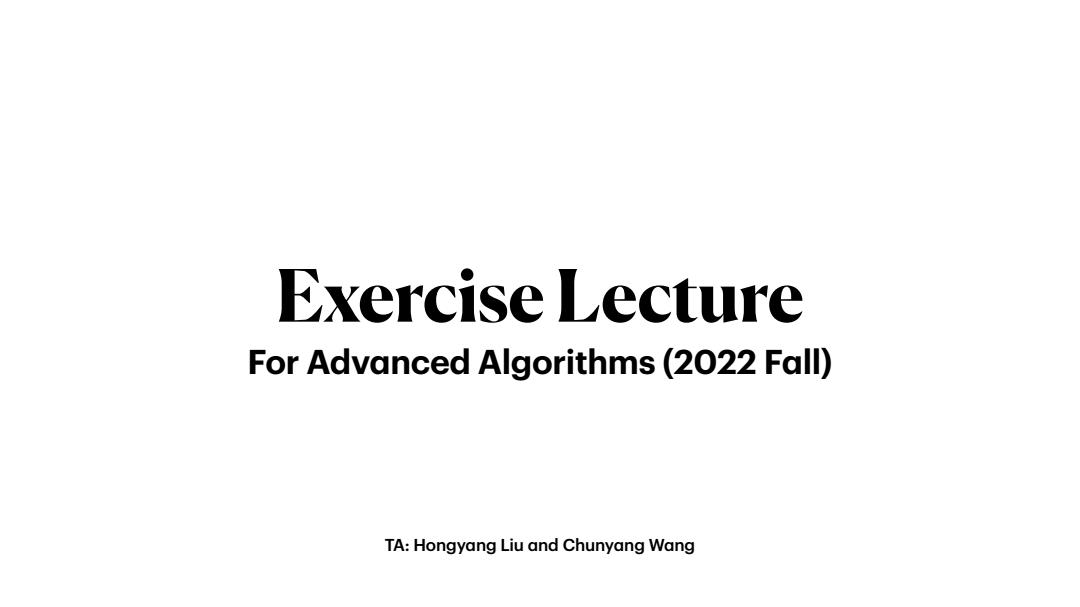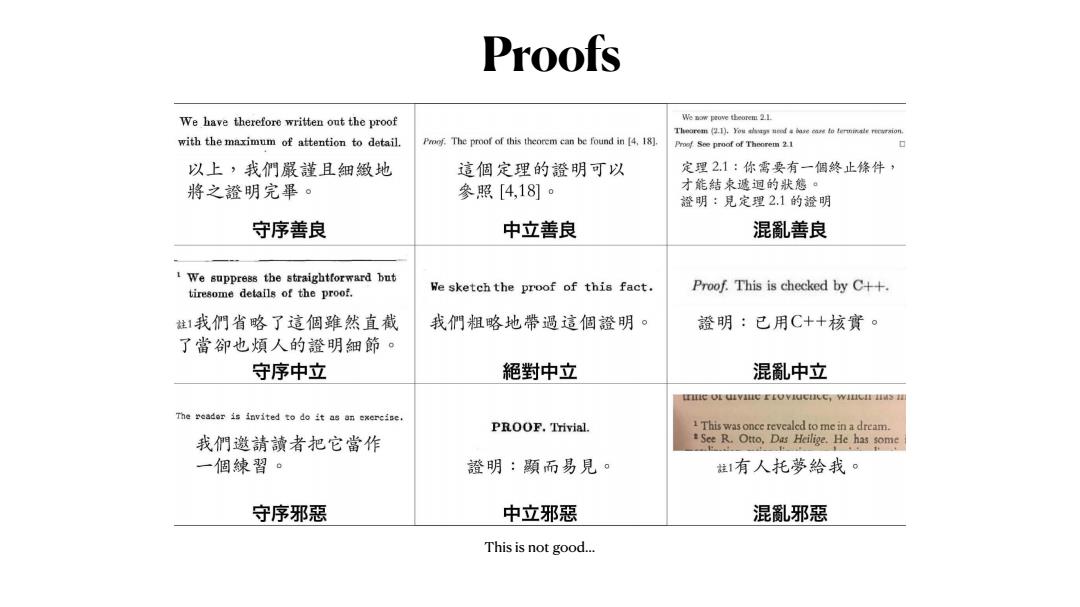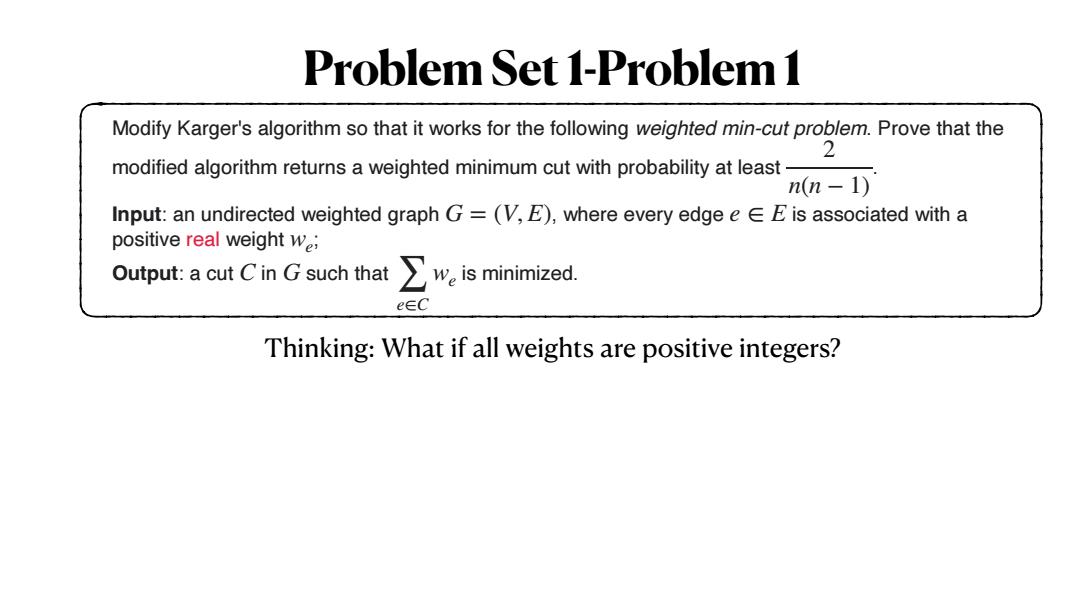
Exercise Lecture For Advanced Algorithms(2022 Fall) TA:Hongyang Liu and Chunyang Wang
TA: Hongyang Liu and Chunyang Wang Exercise Lecture For Advanced Algorithms (2022 Fall)

Proofs We have therefore written out the proof 形peove theorem2l Thearem得.I.ou alsags med年asecae to berinale reraion.. with the maximum of attention to detail. Proof.The proof of this theorem can be found in [4.18]. Proof See proof of Theorem 21 以上,我們嚴謹且细緻地 這個定理的證明可以 定理21:你雪要有一個终止徐件, 將之證明完畢。 參照[4,18] 才能結束遞迥的狀態。 證明:見定理2.1的證明 守序善良 中立善良 混亂善良 We suppress the straightforward but tiresome details of the proof. We sketch the proof of this fact. Proof.This is checked by C++. 雄1我們省略了這個雖然直截 我們粗略地帶過這個證明。 證明:已用C++核實。 了當卻也煩人的證明細節· 守序中立 絕對中立 混亂中立 trc or uivine rroviucnee,wIncn Ius I The peador is invited to do it as an exereise PROOF.Trivial. 1This was once revealed to me in a dream. 我們邀請讀者把它當作 See R.Otto,Das Heilige.He has some 一個練習。 證明:顯而易見。 姓1有人托夢給我。 守序邪惡 中立邪惡 混亂邪惡 This is not good
Proofs This is not good…

Some tips on writing proofs 1.Write in complete sentences.You should write proofs like you are writing an article. Use conjunctions like "suppose that","therefore","hence"instead of.and.. 2.Avoid imprecision in proofs. Label(i.e.,name)all relevant objects Define any new terms you are using Avoid informal language,e.g.,contractions,hand-wavy statements,etc. 3.Don't skip nontrivial steps.Explain your arguments.Please let me know clearly you really understand your arguments so that I don't have to guess your purpose and possibly deduct your points
Some tips on writing proofs 1. Write in complete sentences. You should write proofs like you are writing an article. Use conjunctions like “suppose that”, “therefore”, “hence” instead of and 2. Avoid imprecision in proofs. • Label (i.e., name) all relevant objects • Define any new terms you are using •Avoid informal language, e.g., contractions, hand-wavy statements, etc. 3. Don’t skip nontrivial steps. Explain your arguments. Please let me know clearly you really understand your arguments so that I don’t have to guess your purpose and possibly deduct your points. ∵ ∴

Problem Set 1-Problem 1 Modify Karger's algorithm so that it works for the following weighted min-cut problem.Prove that the 2 modified algorithm returns a weighted minimum cut with probability at least n(n-1) Input:an undirected weighted graph G=(V,E),where every edge eEE is associated with a positive real weight we; Output:a cut C in G such that ∑wisminimized. e∈C
Problem Set 1-Problem 1 Modify Karger's algorithm so that it works for the following weighted min-cut problem. Prove that the modified algorithm returns a weighted minimum cut with probability at least . Input: an undirected weighted graph , where every edge is associated with a positive real weight ; Output: a cut in such that is minimized. 2 n(n − 1) G = (V, E) e ∈ E we C G ∑ e∈C we

Problem Set 1-Problem 1 Modify Karger's algorithm so that it works for the following weighted min-cut problem.Prove that the 2 modified algorithm returns a weighted minimum cut with probability at least- n(n-1) Input:an undirected weighted graph G=(V,E),where every edge eEE is associated with a positive real weight we; Output:a cut C in G such that ∑wisminimized. e∈C Thinking:What if all weights are positive integers?
Problem Set 1-Problem 1 Modify Karger's algorithm so that it works for the following weighted min-cut problem. Prove that the modified algorithm returns a weighted minimum cut with probability at least . Input: an undirected weighted graph , where every edge is associated with a positive real weight ; Output: a cut in such that is minimized. 2 n(n − 1) G = (V, E) e ∈ E we C G ∑ e∈C we Thinking: What if all weights are positive integers?